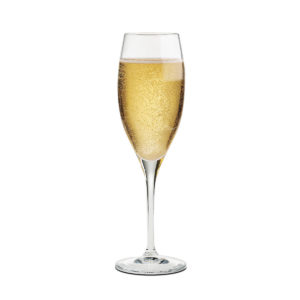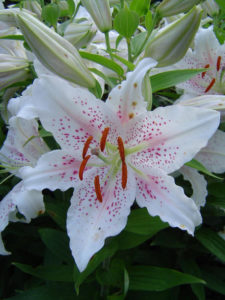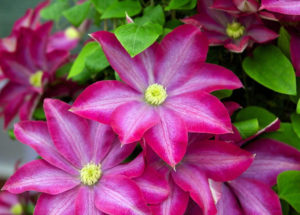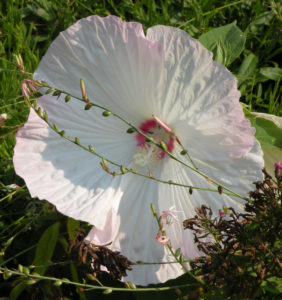
Glass of Champagne-wineenthusiast.com
I love to drink wine – red, white, rosè, or sparkling, take your pick. What I want to drink at the moment depends on my mood and the food I’m eating. Any time I purchase a plant with a wine name, I remember an occasion when I drank that particular varietal.
In April, I discussed plant names derived from Burgundy, Bordeaux, and Pinot Noir. This time, I’ll tell you about plants with Muscadet, Champagne, and Pinot Grigio names.

Lilium ‘Muscadet’-commons.wikimedia.org
Muscadet is a bone-dry, light-bodied white wine from the Loire Valley. Lilium ‘Muscadet’ is an Oriental Lily that has large, recurved, pristine white flowers with delicate pink brushstrokes, dark pink speckles, and dark pink anthers (pollen bearing part of stamen). It grows three to four feet tall, attracts butterflies and hummingbirds, can be planted in a container as a seasonal flower, or can be used as a cut flower (cut as little stem as possible). Plant deeply in rich, organic, well-drained soil in full sun and give it plenty of water and fertilizer. It looks best in groups of three or more and interplanted with other perennials or behind shrubs to disguise its lanky stems.

Papaver nudicale ‘Champagne Bubbles’-riverbendnursery.com
Champagne, of course, comes from the Champagne region in northeastern France. Papaver nudicale ‘Champagne Bubbles’ is a seed mix with graceful, crinkly, crepe-paper-like, fragrant blossoms on 12-18” stems. The colors range from pale to bright yellow, orange, bronze, and scarlet. Known as Iceland Poppy, it blooms from mid-spring to early summer. Sadly, it is a short-lived perennial because it hates heat but often reseeds if the last blossoms are allowed to become deadheads. Remove the faded flowers to encourage rebloom. As a bonus, it has beautifully lobed, pale green basal foliage. It is best used at the front of a border or as a cut flower; cut just as the buds begin to open. Happily, it appears to be deer resistant. Plant in well-drained, gritty soil in full sun or partial shade. It will go dormant in late summer so interplant with other perennials.

Clematis ‘Pink Champagne’-etsy.com
Staying with the champagne theme, you could also add Clematis Pink Champagne™ to your garden but this time, we’d be talking about pink champagne which is usually sweeter. This clematis is one of the earliest large-flowered clematis to bloom. As the name implies, this variety boasts wavy (bubbly?), bright pink petals with paler centers and bright yellow stamens. Pink Champagne™ is a strong climber to seven feet but stays fairly narrow, meaning it works well in tight spaces. Richard Hawke, the director of horticultural research at the Chicago Botanical Garden, grows it and says that the stems shoot straight up, making a beautiful pink exclamation point. Grow in full sun with medium moisture.

Hibiscus ‘Pinot Grigio’
Pinot Grigio is a lovely, dry white wine from Italy and Hibiscus Splash Pinot Grigio is aptly named because the flowers are so large that it definitely makes a splash in the landscape. Like its cousin, Pinot Noir, the plant is compact, well branched, sturdy and deer resistant. Its big white flowers with a pale pink ring at the throat are 12” across on top of large foliage. Blooming from mid to late July through October, it will only grow three feet high and wide. Plant in full sun, give plenty of moisture, and deadhead immediately. It will foliate very late in spring so mark the spot to avoid digging it up because you think it’s dead.
Even if you don’t drink, you can still enjoy alcohol in your garden.


0 Comments